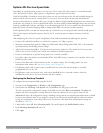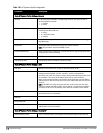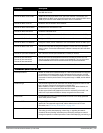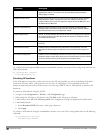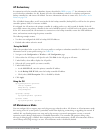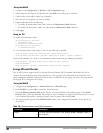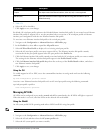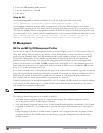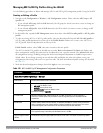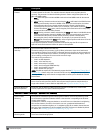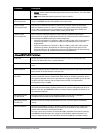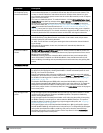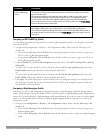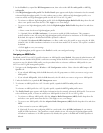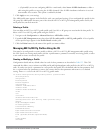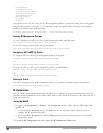
Managing 802.11a/802.11g Profiles Using the WebUI
Use the following procedures to define and manage 802.11a and 802.11g RF management profiles Using the WebUI.
Creating or Editing a Profile
1. Navigate to the Configuration > Wireless > AP Configuration window. Select either the AP Group or AP
Specific tab.
l If you selected AP Group, click the Edit button by the AP group for which you want to create or change an
RF management profile.
l If you selected AP Specific, click the Edit button by the AP for which you want to create or change an RF
management profile.
2. In the Profiles list, expand the RF Management menu, then select either 802.11a radio profile or 802.11g radio
profile.
3. To edit an existing 802.11a or 802.11g radio profile, select the desired profile from the 802.11a radio profile or
802.11g radio profile drop-down list at the top of the Profile Details window-or-To create a new 802.11a or
802.11g profile, click the drop-down list at the top of the
Profile Details window, select NEW, then enter a name for the new profile.
The 802.11a and 802.11g profiles are divided into two tabs, Basic and Advanced. The Basic tab displays only
those configuration settings that often need to be adjusted to suit a specific network. The Advanced tab shows
all configuration settings, including settings that do not need frequent adjustment or should be kept at their
default values. If you change a setting on one tab then click and display the other tab without saving your
configuration, that setting will revert to its previous value. The basic and advanced profile settings are described
in Table 122.
4. Make the desired configuration changes, then click Apply to save your settings.
Parameter Description
Basic 802.11a/802.11g Settings — General
Radio Enable Enable transmissions on this radio band.
Mode Access Point operating mode. Available options are:
l am-mode: Air Monitor mode
l ap-mode: Access Point mode
l spectrum-mode: Spectrum Monitor mode
The default settings is ap-mode.
Transmit EIRP Maximum transmit EIRP in dBm from 0 to 51 in .5 dBm increments, or 127 for regulatory
maximum. Transmit power may be further limited by regulatory domain constraints and AP
capabilities.
Enable CSA Channel Switch Announcements (CSAs), as defined by IEEE 802.11h, enable an AP to announce
that it is switching to a new channel before it begins transmitting on that channel. This allows
clients that support CSA to transition to the new channel with minimal downtime.
TPC power The transmit power advertised in the TPC IE of beacons and probe responses.
The supported range is 0-51 dBm, and the default value is 15 dBm.
High throughput enable
(Radio)
Enable/Disable high-throughput (802.11n) features on the radio. This option is enabled by default.
Table 122:
802.11a/802.11g RF Management Configuration Parameters
DellPowerConnectW-SeriesArubaOS6.2 | User Guide AccessPoints(APs) | 425



